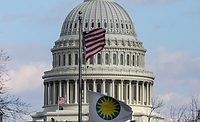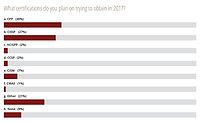Hail to the Chief -- 2017 Inauguration Day Security




Welcoming a new president to lead the free world could endanger far more than one person. Hundreds of key leaders and massive crowds are a tempting target for America's enemies. The inauguration can also be a world stage for disruptive dissent, requiring layer upon layer of security to protect against threats inside and out.
Federal, local and private partners started working in April 2016 to make the 58th presidential inauguration last month on January 20 a showcase of the capital city, said Washington D.C. Mayor Muriel Bowser. “Every four years our government works overtime to keep everyone safe during the peaceful transition of power that is the hallmark of our democracy.”
It wouldn't have been so peaceful if not for fencing that grows stronger every four years. Violent protesters smashed windows and provoked roving skirmishes with the Metropolitan Police Department's Special Operations Unit. Masked youth vandalized or blocked traffic, then regrouped after being dispersed with pepper spray and sound grenades. A limousine that was smashed just east of the White House was set on fire hours later. Landscaping bricks became projectiles and hammers were seen causing more than $100,000 in damage, according to court documents. Windows of Starbucks, Bank of America, Wells Fargo, McDonald's and a local liquor store were smashed. Six police officers were briefly hospitalized and 231 people all currently face one charge: felony rioting.
A variety of shields, facemasks and uniforms were used by the police. “Form a line! Form a line!” one officer shouted to his team as they used their bicycles to protect vulnerable businesses. They were shouted at often, asked how they could defend the new president and his policies. “We're doing our job,” was always the unspoken reply.
A trailer at Franklin Square served as a tiny National Guard base of operations, should crowds at the nearby protest rally or their destructive friends overwhelm DC police. Those soldiers were never called to action, and just around the corner of the roving melees, chaos faded. Nearby streets were quiet, with Trump supporters and opponents strolling peacefully.
Closer to the security zone, however, shouting was as common as countless protest signs. With the parade route between the Capitol and White House more secure than ever, those who vowed to disrupt the celebration focused instead on blocking President Donald Trump's supporters from entering.
Starting at 8:30 a.m., on Inauguration Day, groups locked arms or tied themselves together with ropes or chains at the front of long lines. Their resistance to being dislodged seemed to determine the amount of force police used to remove them. Several times these groups reformed at the adjacent checkpoint, but this tactic seemed to dissipate by early afternoon.
To learn the latest in protester countermeasures, Special Agent in Charge of the Washington Field Office Brian Ebert brought a multi-agency team to Cincinnati last summer as the Republican National Convention was underway. “We're constantly enhancing and tailoring our protective methodologies and bringing new tools and technologies to bear to mitigate these threats,” he told me. As the lead agency of the “National Security Event,” the Secret Service was in charge of development and implementation of the January 20 operational security plan. The Federal Emergency Management Agency handled incident response and recovery operations, and the FBI led incident investigations.
“We conducted numerous joint training initiatives and tabletop and field exercises to ensure that we have an immediate, well-coordinated and effective response to any challenges that might arise,” said Ebert. The Secret Service employs a “unified command model,” he explained. “We established an executive steering committee, staffed with senior reps from those agencies who have primary jurisdiction over the events, supported by 25 subcommittees who focus on components like crowd management, credentialing, fire safety, and health and medical.”
He wouldn't say how long it takes to sweep the apartments and businesses along the parade route, and securing manholes is another off-limits topic, but he did say that neighborhood outreach this year got started in early October. “We reached out to more than 1,500 buildings and over 350,000 people and 5,000 individual businesses and provided them with information on what to expect,” he said.
Five metro subway stations were closed, including, for the first time, the Pentagon station. Bomb and chemical-sniffing dogs were prowling stations all day long.
In the air, routine military and civil VIP flights were all canceled. Any private pilots flying over the city faced a license suspension, civil penalties, jail time and deadly force. The District of Columbia National Guard is in charge of protecting the skies over DC under NORAD's operation Noble Eagle. Special attention was paid to detect and destroy small drones that might fly in, according the US Coast Guard.
The Coast Guard lent MH-65 Dolphin helicopters to offer a secure eye over the inauguration, and 19 vessels protected 27 miles of nearby coastline. “In addition,” says Coast Guard Public Affairs Specialist Nate Littlejohn, “There were Coast Guard K-9 teams protecting shore-side infrastructures.” The Captain of the port, Lonnie Harrison, established a security zone, Littlejohn told me, “To prevent the potentially catastrophic impact a terrorist attack against the large gathering of high-ranking U.S. officials, the public at large, and surrounding waterfront areas and communities could face. The security zone was part of a comprehensive port security plan designed to safeguard human life, vessels, and waterfront facilities against sabotage or terrorist attacks.” What threats may have been deterred can never be known. What was turned away was one man paddling into the security zone. “He was quickly escorted from the area without incident,” he said.
When Bill Clinton was inaugurated there were no barriers preventing anyone from attending the parade. Checkpoint tents with metal detectors and searches were first erected after the election of George W. Bush in 2001, though large groups of protesters easily bypassed them by breaching weak fencing. By 2005, sturdy 10-foot square rubber-coated steel fences lined the parade route, and one coordinated effort to unlatch and breach the fence was repelled by police and pepper spray.
This year, bolts connecting the fence portions were more even more heavy-duty, as were the barricades blocking vehicles from approaching. National Guard trucks and dump trucks filled with sand blocked traffic from coming within blocks of Pennsylvania Avenue, where four years ago empty buses were the primary roadblock. “We use a number of different barriers to prevent a large truck-type situation like we've seen in other parts of the world,” explained Interim Police Chief Peter Newsham. Adjacent sidewalks hosted rows of four concrete barriers, letting pedestrians through, but nothing else.
When they weren't disrupted, the lines through security checkpoints moved more swiftly than four years ago. Bags were swiftly inspected and if a belt was thought to be the reason a metal detector went off, that was accepted. X-ray machines were not in use, so large objects like binoculars were taken at face value.
After Bush's election, metal barriers resembling bicycle racks were used, ineffectively, to close off entire streets. Every four years since, those short barriers have lined Pennsylvania Avenue itself, just ahead of single-file rows of National Guard soldiers and police officers. That final barrier between the parade and the public gets thickened each Year. For Obama's first, it was one line of the common 3-foot high metal barriers. For his second, it was a double line. For Trump's inauguration, the double line became a series of linked squares, extending from the curb into the street to create an empty buffer just in front of the police and soldiers facing into the crowds.
Buses brought 3,200 officers in from around the nation to line the parade route. That's more than the 2,000 officers brought in 2013, while National Guard numbers dropped from 6,000 to 5,000, sent from 42 states. This year, officials wouldn't say how many police departments were represented, though four years ago 86 departments sent officers from as far away as Seattle. Each department's team was assigned a liaison officer from DC, guiding them through the city and coordinating any new orders. All of the visiting police officers and guardsmen were deputized to assist local law enforcement, if needed.
Snipers watched everything below from rooftops. Helicopters and satellites watched from higher still when, after hours of waiting, the executive motorcade slowly rolled down Pennsylvania Avenue.
The presidential state car is a highly-modified Cadillac known as Limo One or, affectionately, “The Beast.” Three models made their world debut Jan. 20, fresh from General Motors at a price of $15.8 million each. Spectators and potential assailants had to wonder which limo held the president, since the license plate of each supercar read, simply, “1.” They were shadowed by two black SUVs with, at times, three agents clinging to the side of each. Just behind were four more limousines, adding layers of confusion if any escape were needed. These were flanked by a series of trucks, which certainly kept large caliber automatic weapons mounted out of view from the public.
More trucks and a few police cars brought the tight motorcade's total vehicle count to at least 30, arranged in a thick oval with two ambulances in the center, one painted completely black. Behind that rolling fortress only two cars rode in a 50-yard gap, ending with double phalanx of twenty police motorcycles with sidecars, with a fortified minibus in the middle.
It took one hour and ten minutes for the ceremonial 1.8 mile drive from the Capitol to the White House. Dozens of Secret Service agents strolled at the edge of the street, and at least a dozen exited the trucks to join the four assigned to the second limo as President Trump, his wife and youngest son exited to walk a short while midway through the parade. They exited once more closer to the end, near the high-priced ticketed seating, and a third time to greet their closest supporters as they entered a reinforced viewing stand in the White House's northern lawn. From there, the First Family watched the parade with marching bands from the military and from high schools, mounted police, historic re-enactors, girl scouts and even farm equipment.
Some of the costs are supported with private donations, but most are covered by the federal government. As for the costs incurred by the capital city that day, Mayor Bowser said, “We expect it all to be reimbursed by the federal government. I think, so far, it's $30 million.” $19 million has already been appropriated, and she expects excess costs to be covered by Congress, as has happened every four years.
About the Author: J.S. Decker is a business journalist from Wisconsin who has covered security at the last five presidential inaugurations. He can be reached at reporterdecker@gmail.com.
Looking for a reprint of this article?
From high-res PDFs to custom plaques, order your copy today!













